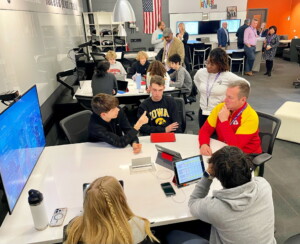Why Does World Language Study Matter?

This year in Atlanta, ISTE drew a record number of attendees, with over 16,000 educators in attendance. Such a large and diverse number of educators can make navigating a conference of this size quite bewildering, to say the least. World language teachers, while relatively few and far between at conferences like ISTE, bring an interesting mix of characteristics to the event that can help mitigate the crowds and lines. Here are 3 characteristics that world language teachers often have that open doors to take advantage of the variety of opportunities that ISTE offers.
1. Globalization and collaboration
Globalization was one of the “hot” ideas at ISTE this year, which featured a packed house at Saturday’s GlobalEd Day, along with a significant number of other conference events devoted to global education. As globalization is beginning to transform world language classrooms, they are beginning to acquire the value that makerspaces have to STEM classrooms. World language teachers can thus take the lead in global education by teaching students the value of cultural fluency and global citizenship by taking action. More world language teachers, along with teachers of a number of other content areas, are embracing classrooms that extend far beyond their own and doing collaborative work with foreign students.
Cathy Davidson explores the idea of “collaboration by difference” in her book Now You See It, and this is exactly what we do at conferences like ISTE, where we are fortunate to learn from other educators. No better example comes to mind than when a group of teachers from different parts of the world decide to forge a collaboration with each other that involves students also working together. I’ve now lost count at how many interactions with teachers living in different areas and teaching different subjects have shed light on problems I’ve been working through and have even illuminated new ones, thanks to these kinds of collaborations. None of this would be possible without looking through a global perspective.
2. Risk-taking and learning from failure
Language learning is founded on taking risks and learning from failure, requiring us to step outside of our comfort zones and confront new challenges. It is only through this process of failure that we learn how to communicate with a second language in a target culture effectively. Therefore, world language classrooms can encourage taking risks by rewarding the attempts over the products.
Few comfort zones involve 16,000 other people crowded together, so choosing to attend ISTE is already an attempt in navigating new territory. Risk-taking happens every time someone volunteers to lead a session or give a presentation or introduces themselves to a Twitter friend. And we move beyond our comfort zone every time we strike up a conversation in the Blogger’s Cafe or when we take the mic at EdTech Karaoke in front of our peers. Like mastering a new language and learning its culture, it’s the attempt in trying something new that enables us to learn more than we otherwise would, if we only went to the same sessions and talked with the same people.
3. Embracement of non-cognitive skills
Alongside the importance of globalization, the value of human capital has reached unprecedented levels, and, thanks to emergent practices like design thinking and mindfulness in classrooms all over the globe, expectation is that it will only continue to climb. In world language classrooms, cultural fluency is becoming just as important as linguistic fluency, which has allowed critically important non-cognitive (or “soft”) skills like empathy, creativity, and the ability to collaborate and think divergently to take center stage.
Empathy may be one of the world language teacher’s most undervalued strengths, and it’s certainly an asset at conferences. ISTE and other large events of its kind are inherently social, and on account of this, we feed off of each others emotions and passions for what we do, which, in part, is what helps to invigorate and rejuvenate our own passions. This year, I was pleasantly surprised in Atlanta at how little “sit and get” PD I saw. Instead, people were almost constantly engaged in conversations and actively listening to each other, whether early morning #coffeeCUE meeting or late evening #brewCUE events.
By taking a “global” view at large conferences like ISTE and embracing the diverse value that each participant brings to them, conference goers stand only to gain by thinking of the event as a global classroom, stepping outside of their comfort zones, and learning just as much about the people in the conference as they do from them. World language teachers who are embracing these new directions in education do much of the same in their own classrooms, thus bringing value to conference events like ISTE.




0 Comments
Leave a Comment
Your email address will not be published. All fields are required.